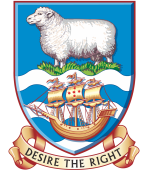Genetic Improvement Programme
Sheep production in the Falkland Islands is based on a self replacing flock producing meat and wool. In the past the key focus was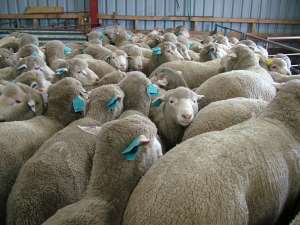 on wool production with meat (mutton) being a secondary product sourced from older animals.
on wool production with meat (mutton) being a secondary product sourced from older animals.
A number of sheep breeds have been used over the Islands' 150 year plus farming history. For much of this time, the Corriedale was the breed that was considered the best fit for the climate and extensive grazing system of the Falkland Islands. First developed in New Zealand, the Corriedale is a Merino crossed with a Lincoln.
They are considered to be hardy, adapted to a wide range of conditions and slightly more fertile than the purebred Merinos. Essentially they are dual purpose producing strong wool (25 – 32 microns) and mutton. Ewes can be used as prime lamb mothers.
Over the past two decades and in line with global trends, the profitability of enterprises producing strong wool and mutton has been in decline. In response to these changing global economic conditions, the Falkland Islands Government embarked on a genetic improvement programme beginning in the early 1990's and continuing today. The programmes aim was to reduce the fibre diameter of the flock while maintaining fleece weight and bodyweight amongst other selection criteria.
The process used in the early stages of this programme was the importation of several hundred live Polwarth stud sheep, which formed the nucleus of the National Stud Flock (NSF). The NSF remains today and is a pedigree and performance recorded flock. The main selection criteria for animals is based on the key production traits of fibre diameter, fleece weight, bodyweight and fertility. This objective selection is combined with key visual assessments of structure, wool quality (style), face cover and pigmented fibres. A new production trait relating to internal parasite resistance was included in 2008.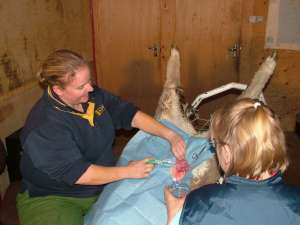
The introduction of the NSF and the production of seedstock for the Falkland Island sheep industry have been instrumental in achieving a reduction in the average fibre diameter of the national flock from approximately 27.5 micron in 1990 to approximately 25 micron in 2008.
The process used in the latter stages of this programme has been to expand the breed base by introducing new breeds. This has included breeds such as Dohne Merino, South African Meat Merino (SAMM), Afrino, fine and medium wool Merinos, Cormos (comeback), Pool Dorset, Texel and Suffolk. The latest reproductive technologies of fresh and frozen embryo transfer (ET) along with laproscopic (AI) and cervical (CAI) artificial insemination have been used to propagate the breeds as quickly as possible and build sufficient critical mass for the Falkland Islands to be self sufficient. This has been done in response to changes within the domestic meat industry and the continued global trend towards finer fibre diameter. All animals used in the latter stage have been selected on their performance data (estimated breeding values when available) with a selection of the dual purpose breeds being monitored to measure their performance and adaptation to the Falkland Islands farming environment. The aim is to integrate the purebreds into the national flock to aid its future development by continuing its dual purpose production focus and provide the capability to produce lamb as well as mutton.
Mid-Side Services
NZWTA
One of the options for testing mid-side samples is sending them to the New Zealand Wool Testing Authority (NZWTA) for testing.
NZWTA offer several testing options such as;
- Micron Only
- Micron & Yield
- Micron & Yield and Length & Strength
If you would like to send your mid-side samples to NZWTA then get in touch with the DoA on 27355 or email This email address is being protected from spambots. You need JavaScript enabled to view it.
If you are sending samples to be tested by NZWTA then you will need to send your samples to the Department of Agriculture where they will then be vac-packed and forwarded on with our regular wool sample parcels to New Zealand. See document below for guidelines on your mid-side samples.
Waiting time for results back from NZWTA is between 1-2 months depending on shipping from the Falklands.
OFDA2000
The other option for mid-sdie testing is using the departments own Optical Fibre Diameter Analyser (OFDA2000). Samples must be a minimum of 45mm to be tested on the OFDA2000.
The OFDA2000 offers sumerous results such as;
- Micron
- Micron deviation
- Standard deviation
- Coefficient of variation of diameter
- Length
- Standard deviation along the staple length
- Comfort factor
- Curvature
- Standard deviation of curvature
- Minimum micron
- Maximum micron
- Finest point from tip
- Standard deviation along the staple
Yield and strength cannot be reported by the OFDA2000.
Waiting time on receiving results for OFDA samples varies on workload within the department. However, if the department is informed well before receiving samples then they can ensure someone is available to carry out the testing with results being sent out in a timely manner.
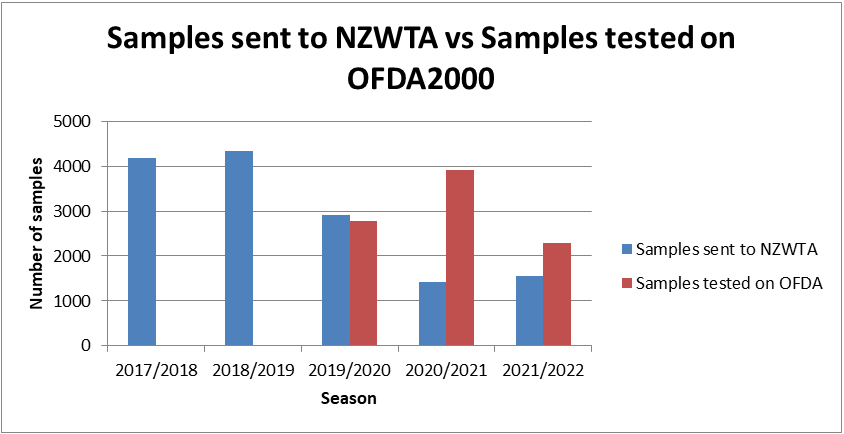
If you would like more information on mid-side sampling then please contact This email address is being protected from spambots. You need JavaScript enabled to view it..
Farm Improvement Programme
The Farm Improvement Programme (FIP) scheme (previously known as the Pasture Improvement Programme) commenced in 1998/99, as a Falkland Islands Government grant for fertiliser (calcified seaweed and rock phosphate), seed, machinery use, fuel and fencing, with the aim of improving pastures on farm across the Islands.
Today the Farm Improvement Programme (FIP) exists to support the sustainable development and resilience of farming in the Falkland Islands. The core goals of FIP are aligned to those of the Department of Agriculture’s forthcoming Strategic Plan and the Islands Plan 2022-2026:
- Enhancing the Agricultural Economy
- Resilient Land and Grazing Systems
- Food Security
- Cross-cutting applications
-
- Monitoring, Adaptation and Innovation
- Capital and Infrastructure Improvement
- New Farm Business Support
CALL FOR APPLICATIONS FOR FY 2025-2026
Application Deadline for FY 25/26: close of business Monday 23rd June 2025
FIP is open for applications and full details, including eligibility and application requirements, can be found in the programme handbook. Please consult the handbook, and the additional forms and resources below, carefully when preparing your application. The DoA Advising team are happy to assist potential applicants in preparing their submission
 Farm Improvement Programme Handbook 2025-2026 Created: Wednesday, 21 May 2025 15:47 | Size: 422.17 KB
Farm Improvement Programme Handbook 2025-2026 Created: Wednesday, 21 May 2025 15:47 | Size: 422.17 KB Farm Improvement Programme: Application Form 2025-2026 Created: Wednesday, 21 May 2025 16:27 | Size: 93.03 KB
Farm Improvement Programme: Application Form 2025-2026 Created: Wednesday, 21 May 2025 16:27 | Size: 93.03 KB Farm Improvement Programme: Budget Spreadsheet 2025-2026 Created: Wednesday, 21 May 2025 16:32 | Size: 62 KB
Farm Improvement Programme: Budget Spreadsheet 2025-2026 Created: Wednesday, 21 May 2025 16:32 | Size: 62 KB Farm Improvement Programme: Budget Form (Printable) 2025-2026 Created: Wednesday, 21 May 2025 16:50 | Size: 101.74 KB
Farm Improvement Programme: Budget Form (Printable) 2025-2026 Created: Wednesday, 21 May 2025 16:50 | Size: 101.74 KB Farm Improvement Programme: Example - Application Form Created: Wednesday, 21 May 2025 16:45 | Size: 139.39 KB
Farm Improvement Programme: Example - Application Form Created: Wednesday, 21 May 2025 16:45 | Size: 139.39 KB Farm Improvement Programme: Example - Budget Form Created: Wednesday, 21 May 2025 16:40 | Size: 198.72 KB
Farm Improvement Programme: Example - Budget Form Created: Wednesday, 21 May 2025 16:40 | Size: 198.72 KB
Organics
Although much of the farmland in the Falkland Islands is extensively grazed and free from chemicals, to obtain a market premium for wool or meat produce, farms need to be organically accredited.
The Falkland Islands Development Scheme (FIDC) set up a locally accredited organics scheme in March 2001, which a number of farms joined up to. However, in order to be internationally recognised as organic, farms would need to sign up to an international accreditation scheme.
Following investigation, it was found that the Biological Farmers of Australia (BFA) provided a scheme that would adapt easily to the Falkland Islands, as it was designed to cater for a similar extensive or rangeland grazing management system.
Sheep Ultrasound Pregnancy Diagnosis
Since 2002 the Department of Agriculture has been able to offer a Ewe Ultrasound Pregnancy Diagnosis (scanning) to farmers.
Worldwide, scanning is used as an important management tool. It allows producers to relatively accurately predict lambing percentage. These results are the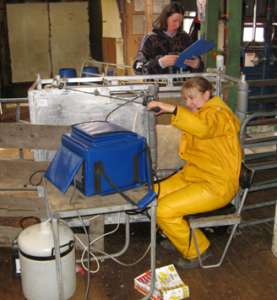 n used to alter or fine-tune management practises relating to nutrition, health and pasture use. This practise has therefore fitted neatly into the Farm Improvement Programme.
n used to alter or fine-tune management practises relating to nutrition, health and pasture use. This practise has therefore fitted neatly into the Farm Improvement Programme.
The scanning information can also be utilised as a financial forecasting tool: i.e. cash flow budgets, enabling better estimates of income and expenses.
The benefits of determining if a ewe is pregnant or not include:
- Being able to plan and budget for feeding/pasture – dry ewes can be run as wethers, ewes with multiple lambs can be moved to best pastures and fed supplements as required.
- Being able to see what your conception rates are compared to lambs born or lambs marked. Marked differences in conception to weaning rate can be investigated.
- Being able to see if any particular ewes are consistently not producing a lamb, they should be removed from the flock.
- Being able to estimate conception rates lambing percentage to enable you to forecast meat or wool income.
- Being able to body condition score pregnant ewes and feed those that need extra accordingly, or cull them if they are never going to successfully raise a lamb.
Facilities needed:
- Pens and race – a temporary race made out of pens/gates is fine. For optimum flow of sheep have the panels before the scanning crate solid or covered so the sheep cannot see the scanner.
- A continuous supply of hot and cold water - access to a working kettle is fine for the hot water supply.
- A reliable power source.
- Sufficient workforce – 1 person to work the crate/drafting gates, 1-2 people to push sheep up the race and fill pens and 1 person to write tag numbers etc. if required.
- Ideally scanning would occur in a shed with easy access to power and water but scanning in the field is possible with prior arrangement
When to scan:
- Naturally mated ewes
- A short joining period of 34 days (2 cycles) is advisable. It is important (for many reasons) that rams are taken OFF the ewes. Scanning is optimal from 42-45 days from when the ram is taken off. Added benefits of a short joining period are:
- A short and concise lambing period
- A shorter time period needed to spend shepherding
- All lambs will be nearer in age for weaning/lamb marking
- A short joining period of 34 days (2 cycles) is advisable. It is important (for many reasons) that rams are taken OFF the ewes. Scanning is optimal from 42-45 days from when the ram is taken off. Added benefits of a short joining period are:
Longer joining periods may mean that 2 scanning sessions are needed to accurately detect all pregnancies which will obviously be more costly and time consuming
- AI ewes and Cover Rams:
- Any ewes that don’t conceive at AI should cycle and be fertile again 17 days after the AI attempt, therefore to ensure a concise lambing period put cover rams out 2 weeks after the AI day for 35 days (2 cycles)
- It is important to have raddle or harnesses on your rams. Marked ewes can be assumed to be cycling and not to have conceived via AI so if they are scanned pregnant it can be noted that this is probably to cover ram that the AI.
- Scanning should occur between 70-90 days after the AI date.
Other information:
- Ewes need to be off food and water overnight/twelve hours before scanning. Accurate scanning with a full rumen is both difficult and hard work.
- Having the ewes half bellied makes the job much quicker and easier.
- Please contact in good time, with all relevant dates and information so logistics can be arranged.
HOW TO BOOK YOUR SCANNING:
This email address is being protected from spambots. You need JavaScript enabled to view it.
Please let us know the dates when the rams went in and off and how many ewes there are to scan.
